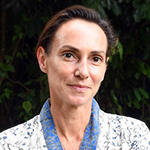 Chercheure
Chercheure
Cirad Montpellier
CIFOR, en accueil
Cirad, UMR Eco&Sols /
Centre international de recherche sur les forêts
Campus La Gaillarde Institut Agro - INRAE - Bat 12 - 1er étage
2 place Viala - 34060 Montpellier
Email : This email address is being protected from spambots. You need JavaScript enabled to view it. / This email address is being protected from spambots. You need JavaScript enabled to view it.
https://www.cifor.org/research-staff/2785/kristell-hergoualch
https://scholar.google.com/citations?user=J60lrkoAAAAJ&hl=en
https://www.researchgate.net/profile/Kristell_Hergoualch
Chercheure sénior en fonctionnement des écosystèmes
Parcours
Je suis chercheuse en fonctionnement des écosystèmes au sein de l’équipe changement climatique, énergie et développement à faible émission de carbone (CCE) du CIFOR, accueillie au CIRAD au sein the l’UMR Eco&Sols. Je m’intéresse depuis plus de 15 ans à l’atténuation du changement climatique dans les pays tropicaux, notamment en Indonésie, au Pérou et au Costa Rica. Je me suis spécialisée dans les impacts que la déforestation, la dégradation des forêts et le changement d'affectation des terres ont sur les cycles biogéochimiques, les flux de gaz à effet de serre et les stocks de carbone. Je suis auteure de plusieurs rapports du GIEC, notamment le supplément de 2013 aux lignes directrices de 2006 pour les inventaires nationaux de gaz à effet de serre (GES) sur les zones humides et la révision de 2019 des lignes directrices de 2006 pour les inventaires nationaux de GES. Ses activités de recherche portent sur la foresterie, l'agroforesterie, l'agriculture, le changement d'affectation des terres, sur sols minéraux et organiques en particulier dans les tourbières.
Bibliographie selective
Aini FK, Hergoualc’h K, Smith JU, Verchot L, Martius C (2020) How does replacing natural forests with rubber and oil palm plantations affect soil respiration and methane fluxes? Ecosphere, 11, e03284. https://esajournals.onlinelibrary.wiley.com/doi/abs/10.1002/ecs2.3284
Griffis TJ, Roman TD, Wood JD et al. (2020) Hydrometeorological sensitivities of net ecosystem carbon dioxide and methane exchange of an Amazonian palm swamp peatland. Agricultural and forest meteorology, 295, 108167. https://www.sciencedirect.com/science/article/pii/S0168192320302690?dgcid=coauthor
Hergoualc’h K. 2020. Les tourbières du sud-est asiatique. Un avenir précaire. Le Courrier De La Nature, numéro spécial Les tourbières. Des milieux à redécouvrir : 52-55. https://www.snpn.com/produit/le-courrier-de-la-nature-special-tourbieres/
Hergoualc’h K, Akiyama H, Bernoux M et al. (2019) Chapter 11 N2O emissions from managed soils and CO2 emissions from lime and urea application. In: 2019 Refinement to the 2006 IPCC Guidelines for National Greenhouse Gas Inventories – Volume 4 Agriculture, Forestry and Other Land Use. (eds Calvo Buendia E, Tanabe K, Kranjc A, Baasansuren J, Fukuda M, S. N, Osako A, Pyrozhenko Y, Shermanau P, Federici S). Switzerland, Intergovernmental Panel on Climate Change. https://www.ipcc-nggip.iges.or.jp/public/2019rf/pdf/4_Volume4/19R_V4_Ch11_Soils_N2O_CO2.pdf
Hergoualc’h K, Dezzeo N, Verchot LV, Martius C, Van Lent J, Del Aguila-Pasquel J, López Gonzales M (2020) Spatial and temporal variability of soil N2O and CH4 fluxes along a degradation gradient in a palm swamp peat forest in the Peruvian Amazon. Global Change Biology, 26, 7198-7216. https://onlinelibrary.wiley.com/doi/abs/10.1111/gcb.15354
López Gonzales M, Hergoualc’h K, Álvarez Alonso J et al. (2020) What do we know about Peruvian peatlands?, Occasional Paper 209. Bogor, Indonesia, CIFOR. https://www.cifor.org/knowledge/publication/7848
Málaga N, Hergoualc’h K, Kapp G, Martius C (2020) Variation in Vegetation and Ecosystem Carbon Stock Due to the Conversion of Disturbed Forest to Oil Palm Plantation in Peruvian Amazonia. Ecosystems. https://link.springer.com/article/10.1007/s10021-020-00521-8
Novita N, Kauffman JB, Hergoualc’h K, Murdiyarso D, Tryanto DH, Jupesta J (2021) Carbon Stocks from Peat Swamp Forest and Oil Palm Plantation in Central Kalimantan, Indonesia. In: Climate Change Research, Policy and Actions in Indonesia: Science, Adaptation and Mitigation. (eds Djalante R, Jupesta J, Aldrian E) pp Page. Cham, Springer International Publishing. https://link.springer.com/chapter/10.1007/978-3-030-55536-8_10
Ogle S, Wakelin SJ, Buendia L et al. (2019) Chapter 5 Cropland. In: 2019 Refinement to the 2006 IPCC Guidelines for National Greenhouse Gas Inventories – Volume 4 Agriculture, Forestry and Other Land Use. (eds Calvo Buendia E, Tanabe K, Kranjc A, Baasansuren J, Fukuda M, S. N, Osako A, Pyrozhenko Y, Shermanau P, Federici S). Switzerland, Intergovernmental Panel on Climate Change. https://www.ipcc-nggip.iges.or.jp/public/2019rf/pdf/4_Volume4/19R_V4_Ch05_Cropland.pdf
Skiba U, Hergoualc’h K, Drewer J, Meijide A, Knohl A (2020) Oil palm plantations are large sources of nitrous oxide, but where are the data to quantify the impact on global warming? Current Opinion in Environmental Sustainability, 47, 81-88. https://www.sciencedirect.com/science/article/abs/pii/S1877343520300749






